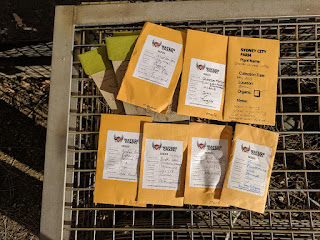Seed Saving
Markus and I attended a workshop at the Sydney City Farm last weekend which was about seed saving - the what, why and how.
The session was led by Jon who amongst other things is running the rooftop garden at the Wayside Chapel and active in the Inner West Seed Savers group.
Here is a summary of take-away points from the workshop:
Seed saving also helps to maintain biodiversity and grow plants that are suited and adjusted to the local micro climate making them more robust and plentiful.
The wet method is used for all seeds that are encapsulated in a gel pouch like tomato seeds. To harvest the seeds they are added with water into a closed jar and left to ferment till the seeds sink to the bottom.
The seeds are rinsed and dried afterwards and stored like any other seed.
With the dry method the dried seed pods or flowers are used as they are and the seeds extracted from them.
This can be done by rubbing them between your palms and using different sizes of sieves to filter out the chaff.
Seeds also need to be completely dry and then stored in airtight plastic bags or containers. It helps to leave them out in the sun for about 5 min in summer and up to an hour in winter after extraction to make sure they are completely dry and also free of vermin.
The session was led by Jon who amongst other things is running the rooftop garden at the Wayside Chapel and active in the Inner West Seed Savers group.
Here is a summary of take-away points from the workshop:
Why save seeds?
The most obvious reason is to save money. Seeds are not that cheap and not all seeds sown will germinate or make it into a mature plant.Seed saving also helps to maintain biodiversity and grow plants that are suited and adjusted to the local micro climate making them more robust and plentiful.
Wet and dry method
There are mostly two methods: wet and dry.The wet method is used for all seeds that are encapsulated in a gel pouch like tomato seeds. To harvest the seeds they are added with water into a closed jar and left to ferment till the seeds sink to the bottom.
The seeds are rinsed and dried afterwards and stored like any other seed.
With the dry method the dried seed pods or flowers are used as they are and the seeds extracted from them.
This can be done by rubbing them between your palms and using different sizes of sieves to filter out the chaff.
Labeling and storing
Once collected seeds tend to all look very similar. It is therefore important to label them properly. Ideally with their common and botanic name and the date and place of collection. Seeds are as a rule of thumb only viable for about a year. Therefore knowing when the seeds were collected is important.Seeds also need to be completely dry and then stored in airtight plastic bags or containers. It helps to leave them out in the sun for about 5 min in summer and up to an hour in winter after extraction to make sure they are completely dry and also free of vermin.
 |
| A few samples from the seed saving workshop |


Comments
Post a Comment